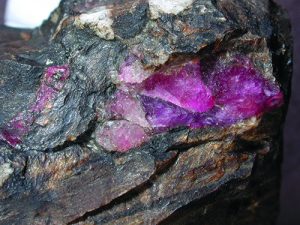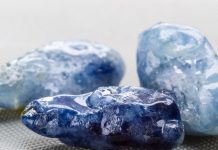
How do gemstones get their color? A small cluster of transition metal elements plays a major role in determining the value of many popular and valuable gems. For example, zoisite is usually an opaque pink thanks to manganese and green because of a trace of chromium. But the zoisite variety of tanzanite is a vibrant blue to violet. Tanzanite with a brownish tint is because of a trace of vanadium.
Impact of Trace Impurities

The importance of trace impurities of transition metal elements in otherwise less attractive gems can not be overstated. Except for diamonds, which have high value even when colorless, it is the colorful gems that command higher prices in the market.
The transition metal elements that cause more colors in gems than any other are iron, chromium, vanadium, and titanium. In some cases like ruby, the trace metal acts as a single chromophore locked in the geometry of the corundum’s atomic structure. In many other cases, it takes two transition metal elements working in concert with oxygen atoms to give a gem the color we adore. A good example of this is padparadscha orange sapphire, another corundum. This type of sapphire is highly prized because of its rare color.
Atomic Structure
While most colorful opaque minerals get their color from a simple act of an included transition metal element, the colors we see in many gems are because of much more complicated electron action and each crystal’s atomic structure. The distance between atoms in the structure determines the energy transition electrons must gain to move or shift.
Tanzanite is a great example of this relationship between electrons, distances traveled within the molecule’s structure and the amount of light energy absorbed. Viewed in one direction, a tanzanite crystal is blue. Turn it ninety degrees and its color is violet. Look down the length of the same crystal and you will see burgundy red. This is trichroism and is caused by the energy electrons require to move different distances in the mineral’s atomic structure when viewed from different directions.

Hannes Grobe, Wikimedia Commons
Cause of Color in Common Gems
What causes the color in the more common colorful gems such as garnets, amber, sugilite, chrysoprase, coral, peridot, sodalite, lapis and jade?
Color in amber ranges from pale yellow to a rich orange-yellow and even blue, which is natural and caused by the organic mineral’s chemistry. Its internal structure is such that its electrons, not impurities, simply charge transfer back and forth, causing the energy of light to be out of balance creating a visible color.
Chalcedony Color
Chalcedony is normally gray-white but can exhibit all sorts of colors with the right impurities. With a little copper, it takes on a grand green color. With uranium oxide atoms included it will fluoresce bright green under short-wave excitation. Infuse the same cryptocrystalline chalcedony with submicroscopic particles of a nickel clay and the lovely green gem gets a different name, chrysoprase.

Parent Géry, Wikimedia Commons
Sugilite is chalcedony infused with violet sugilite. The solid opaque form of sugilite gets its color from manganese and iron acting in coordination. But the gem form of sugilite-chalcedony is infused with microscopic particles of solid sugilite hence the violet color. This is far more valuable and popular than opaque sugilite as it is a gem violet chalcedony.
Jade Color
When we think of jade, we usually think of the massive green material so popular for thousands of years in China and now found throughout the world. Technically, there is no such mineral as green jade only nephrite and jadeite. In the orient, jade can be any green mineral.
Nephrite is the much more common jade mineral. It is formed by combining two minerals, tremolite and actinolite. Tight interlocking fibrous needles give nephrite its toughness. The rich green color in nephrite is because of iron and sometimes chromium.
Jadeite is true jade, single mineral sodium, aluminum silicate sometimes with minor amounts of other minerals. Its color can range from porcelain white to yellow to green to violet with each color because of a different chromophore. Yellow-green in jadeite is because of iron and green jadeite is because of chromium. The rare violet jadeite is because of electrons transferring between iron and oxygen to iron.
Mining Peridot Mesa
In Arizona, the green gem olivine variety of peridot is mined by locals on the reservation from a volcanic outcrop called Peridot Mesa. Peridot can be one of two minerals, forsterite, and fayalite, so the gem’s color ranges from lovely green to light brownish green all because of iron. The volcanic olivine green sand from Hawaii is green because of a trace of chromium.
Sodalite & Lapis
Sodalite is a lovely massive blue mineral used in jewelry and carvings. It can be mistaken or substituted for lapis. Sodalite’s blue color comes from oxygen substituting for aluminum or silicon atoms as shifting electrons use light energy.
There are two other blue minerals with similar names, lazulite and lapis lazuli. Lazulite is found in sharp dark bluish crystals and is not as rich a blue as the other mineral, lapis lazuli. Lazulite is found in different types of deposits, from pegmatites to metamorphic rock. Lapis gets its rich blue color from a charge transfer of electrons between iron to oxygen to iron. A pale blue type of lapis containing lots of calcite is often called denim lapis.
Lapis lazuli is the earliest known gem mined by humans and is found in the Sar-e-Sang (Sar-i-Sang) district of Badakhshan, northeast Afghanistan, the major source. It occurs in white limestone marble in pods and masses, sometimes as fine dark blue dodecahedral crystals. The color of lapis ranges from a distinct good blue to dark blue and has been cut, carved and worked for jewelry, royal regalia and art objects as long as humans have collected gems.
The cause of color in lapis is quite odd. Its chemistry is complex sodium, calcium, sulfur and aluminum silicate. The sulfur atoms in the structure are the cause of color as they absorb light energy and charge transfer their outer orbital electrons among themselves using longwave energy from the red end of the spectrum which makes blue light energy dominant. Because of the continued difficulty and rarity in mining lapis, blue lapis is being simulated, dyed and otherwise treated, making it difficult for the average rockhound to identify natural specimens.
Garnet
One of the largest gem families that are popular, colorful, plentiful and useful are garnets. They range from very common and universally available like almandine to quite rare and valuable as gems like tsavorite, a variety of grossular.
There are nearly twenty recognized members of the garnet family, but only seven or eight are very popular and commonly used as gemstones, specimens and for industrial use. These are almandine, pyrope, spessartine, andradite, grossular and uvarovite. Though there are colorless garnets, those with color have traces of transition metal elements in them including iron, manganese, chromium, vanadium or titanium.

Matthew Goodwin, Wikimedia Commons
Members of the garnet family are the more common state gemstones. Among the states that have garnets as their state gem are, New York choosing the red almandine from the Gore Mountain area, Idaho choosing star garnets with rutile inclusions causing the star pattern and Vermont selecting grossular, certainly because of the lovely intense orange garnets from the Eden Mills area.
Elusive Tsavorite
While fine garnet crystals are available to virtually all collectors, the one gem garnet that is out of reach for most is green tsavorite crystals. This garnet equals and often rivals the finest emeralds for color, clarity, and value. Like emeralds, tsavorite crystals gain their color from trace inclusions of chromium and vanadium.
There are far more inexpensive gem crystals available to rockhounds than are listed here. Their sharp crystal form, availability to the collector, varieties of color and occurrences make garnets an ideal family of minerals to collect.
This story about what causes the color in gemstones previously appeared in Rock & Gem magazine. Click here to subscribe. Story by Bob Jones.













